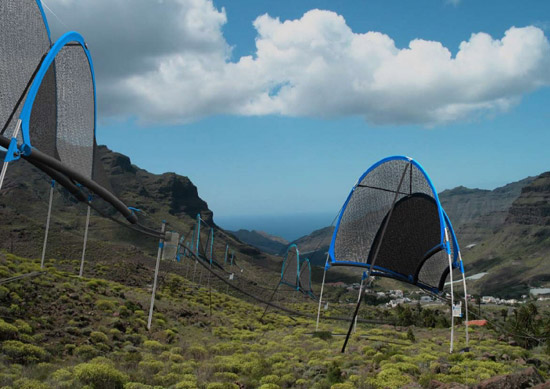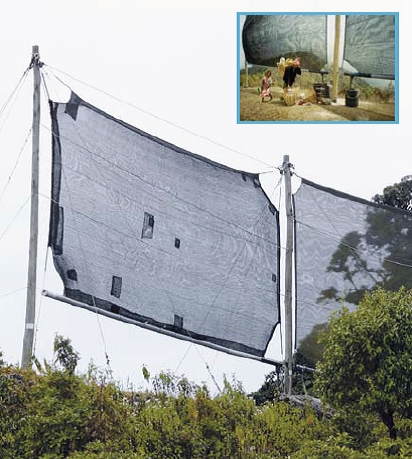Difference between revisions of "Water Portal / Rainwater Harvesting / Fog and dew collection / Fog collection and storage"
(→Suitable conditions) |
|||
| Line 9: | Line 9: | ||
==Suitable conditions == | ==Suitable conditions == | ||
{{Climate_change | {{Climate_change | ||
| − | Changes in sea surface temperatures or temperatures in the atmosphere can change the height of cloud bases or influence the extent of the cloud decks. Therefore be sure to site the collection nets in the middle of the most dense region of fog. If climate change causes the cloud patterns to move, the nets will need to be moved to maximise the area of greatest fog density. | + | Temperature changes=Changes in sea surface temperatures or temperatures in the atmosphere can change the height of cloud bases or influence the extent of the cloud decks. Therefore be sure to site the collection nets in the middle of the most dense region of fog. If climate change causes the cloud patterns to move, the nets will need to be moved to maximise the area of greatest fog density. |
}} | }} | ||
Revision as of 20:48, 20 April 2012
Fog water collection uses large polypropylene mesh nets on ridges to capture water-loaded fog, which forms in humid months in mountainous regions or coastal areas. The meshes are erected perpendicular to the prevailing wind. The mesh captures small water droplets (1 to 40 μm), which trickle into a collection trough or gutter and drain into a series of tanks. Trees and grass intercept fog in a similar way.
Intercepted fog is commonly of a good quality, but may be affected by air pollution, dirt on roofs or rust on metal sheets. If measures are taken to prevent the first polluted flush entering storage tanks, water can be fit for drinking and other domestic use with little or no treatment.
Suitable conditions
{{Climate_change Temperature changes=Changes in sea surface temperatures or temperatures in the atmosphere can change the height of cloud bases or influence the extent of the cloud decks. Therefore be sure to site the collection nets in the middle of the most dense region of fog. If climate change causes the cloud patterns to move, the nets will need to be moved to maximise the area of greatest fog density. }}
Fog collection is most suitable for locations with frequent fog periods. Upland areas where fog is produced by the advection of clouds over the terrain or where clouds are forced to rise over mountains are most suitable, in areas of prevailing winds between 3 - 12 m/s and with no obstructions to wind flow. Fog formed on the ocean surface, or nocturnal radiation fogs in low-lying areas normally lack sufficient liquid water content or sufficient wind speeds for substantial water collection. Examine meteorological records and consult local people about their observations.
A number of meteorological and geographic considerations are important in choosing a site: predominant wind direction, clouds forming below the maximum terrain height, sufficient space for the fog collectors, and no major terrain obstacles. In the case of coastal cloud decks, the mountain range should be within 5 or 10 km of the coast.
If sufficient water is collected, vegetation or crops can also be planted and sustained. Once vegetation is established, it can sustain itself by catching the fog droplets directly.
| Advantages | Disadvantages/limitations |
|---|---|
| - Low project costs - Simple technology and maintenance |
- Frequent fog presence is needed - Relatively small water quantities can be harvested |
Construction, operation & maintenance

Once a polypropylene net is obtained, use it correctly in a double layer. This is normally either polypropylene or polyethylene, u/v protected, with 35% shade coefficient, Raschel mesh weave, and a 1mm fibre size. Efficiency increases with smaller mesh sizes and fibre width.
Net area needs to be large enough to collect the required amount of water. Typical dimensions per net might be 12m long x 4m high (48m2). Typical collection rates vary according to the site but seem to average out at anywhere between 2 litres up to 5 litres per m2 per day, with maximums up to 10 litres per m2 per day.
Space the nets at 5 metre intervals along the contour (horizontally) and at a distance equal or greater to 60 times the fog collector height in an uphill/downhill direction. This allows for the most efficient collection of fog. It also means that wind damage is less likely compared with collectors that are joined together. In general, these flat units are good for wind speeds up to 20m/s. Cables should be protected within garden hose to prevent them causing erosion of the structure.
Typical water production rates from a fog collector range from 150 to 750 litres per day but some schemes are capable of producing 2,000 to 5,000 litres per day. Efficiency of collection improves with larger fog droplets, higher wind speeds, and narrower collection fibers / mesh width. In addition, the mesh should have good drainage characteristics. In high winds, nets would normally be taken down as part of normal operation and maintenance.
Maintenance
A polypropylene mesh has a lifetime of about ten years. In Nepal, operation and maintenance is difficult due to the unavailability of spare parts (mainly polypropylene mesh). Hence keeping stock of mesh and other spare parts is highly recommended. In high winds, nets would normally be taken down as part of normal operation and maintenance. Otherwise where fog collectors are remotely located, different designs are being researched which may provide increased robustness.
Costs
- Material: Polypropylene mesh per 1 m2 (Peru and Chile): US$ 0.25
- Labour: construction and installation of large fog collectors, reservoir tanks and taps:
- Skilled labour: 140 man days (Nepal): US$ 4 per day
- Unskilled labour: 400 man days (Nepal): US$ 2.75 per day
- All inclusive (materials, labour):
- Fog collectors including building materials: US$ 100 - 200
- 48 m2 fog collector providing 3 l/m2/day: US$ 378
- Cost per m2 (Nepal, including reservoir and tap): US$ 60
Field experiences
Fog water collection is used in Nepal, Peru, Chile, etc.
The largest site in Guatemala produces 7,000 litres per day during the dry season. In Nepal, cost per m2 was $60, which included all materials for nets and reservoirs, plus labour.
Reference manuals, videos & links
- FogQuest
- NEWAH information on fog water collection. Nepal Water for Health (NEWAH)homepage.
- Tapping into Fog, IDRC. International Development Research Centre (IDRC) homepage
- Fogwater Harvesting for Community Water Supply MSc Thesis, Cranfield University
- The Environment Canada Handbook on Fog and Fog Forecasting Environment Canada.
Acknowledgments
Articles produced from the following documents:
- CARE Nederland, Desk Study Resilient WASH systems in drought prone areas. October 2010.
- Smart Water Harvesting Solutions: Examples of innovative, low cost technologies for rain, fog, and runoff water and groundwater. Netherlands Water Partnership, Aqua for All, Agromisa, et al. 2007.

